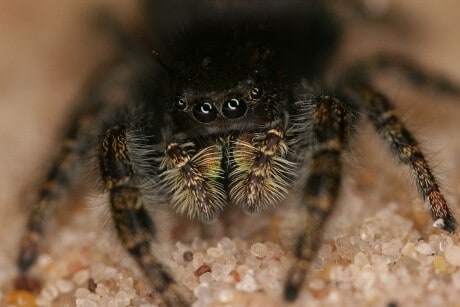While jumping spiders are known to have great vision, a new Cornell study proves for the first time that spiders can hear at a distance.
The discovery runs counter to standard textbook wisdom that claimed spiders could only detect nearby sounds.
A study published online Oct. 13 in the journal Current Biology describes how researchers used metal microelectrodes in a jumping spider’s poppy-seed-sized brain to show that auditory neurons can sense far-field sounds, at distances up to 3 meters, or about 600 spider body lengths.
In further tests, researchers stimulated sensitive long hairs on the spider’s legs and body – previously known to pick up near-field airflow and vibrations – which generated a response in the same neurons that fired after hearing distant sounds, providing evidence the hairs are likely detecting nanoscale air particles that become excited from a sound wave.
“We are the first and only lab that has successfully and fully been able to tap into what the spider’s brain is listening to,” said Ron Hoy, professor of neurobiology and behavior and the senior author of the study.
An interdisciplinary team with researchers from fields of psychology, biological statistics and computational biology, medicine, and physics included the study’s co-first authors, Paul Shamble, Ph.D. ’15, a former graduate student in Hoy’s lab who specializes in spiders and is a distinguished science fellow at Harvard University, and Gil Menda, a postdoctoral researcher in Hoy’s lab.
Menda developed the technique for recording the jumping spider’s neural activity.
Standard techniques for studying spider neurology require dissection, which kills the animal because spiders’ bodies are under pressure, so a cut causes the arachnid to quickly bleed and die. Instead, Menda’s method creates a very tiny hole that seals, like a self-sealing tire, around a hair-sized tungsten microelectrode. The electrodes record electrical spikes when neurons fire.
Menda was actually studying visual perception in jumping spiders when his chair squeaked, and neurons suddenly fired. The discovery led him to test reactions to different audio frequencies. He identified an area of the brain that integrates visual and audio stimuli. He also learned the spiders were sensitive to high frequencies and very specific low frequencies, at 90 Hz.
“All the team sat there together and we were thinking, ‘why are they so sensitive to those frequencies?’” Menda said. It turned out 90 Hz is near the same frequency as wing beats of parasitic wasps, the jumping spider’s biggest enemies, which provision their nests with jumping spiders for their young to feed on.
With the help of Ron Miles, professor of mechanical energy at Binghamton University, whose lab has a special quiet room without vibrations, Menda, Miles and undergraduate co-author Katherine Walden ’14, ran experiments with a special cage that allowed them to eliminate vibrations. They used high-speed video and recorded the spider’s behavior when exposed to pulses of sound.
“When we played 90 Hz, 80 percent of the spiders froze” for up to a second, before they turned and jumped, said Menda. By freezing, a classic behavior called a startle response for animals that hear, spiders assess the situation to avoid detection from wasps that scout for movement, before escaping.
The technique opens up studies that link neurology with behavior in all spiders, Hoy said. Menda has since found evidence of hearing in five different spider species: jumping spiders, fishing spiders, wolf spiders, netcasting spiders and house spiders.
The first evidence of far-field hearing in spiders came from Charles Walcott, Cornell professor emeritus of neurobiology and behavior, who in 1959 discovered house spiders could detect audio stimuli from a sensory organ called a lyriform in their legs, but when German researchers tried to duplicate his experiments in another species of spider, they couldn’t, and they claimed Walcott’s findings were an “artifact,” Hoy said.
Future work by Hoy’s lab will investigate audio perception from lyriform organs and will better investigate audio neurons in the brain. The findings could have applications for using hairlike structures for extremely sensitive microphones, such as in hearing aids.
The study was funded by the National Institutes of Health and the National Science Foundation.


